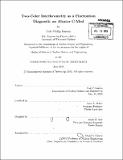Two-Color interferometry as a fluctuation diagnostic on Alcator C-Mod
Author(s)
Kasten, Cale Phillip
DownloadFull printable version (18.88Mb)
Alternative title
2-Color interferometry as a fluctuation diagnostic on Alcator C-Mod
Other Contributors
Massachusetts Institute of Technology. Department of Nuclear Science and Engineering.
Advisor
Anne E. White.
Terms of use
Metadata
Show full item recordAbstract
The two-color interferometer diagnostic on Alcator C-Mod has been upgraded to measure line-integrated electron density fluctuations for turbulence and transport studies. Heterodyne signals from ten vertical-viewing CO2 laser chords are demodulated relative to a local oscillator using high bandwidth analog in-phase/quadrature electronics, replacing lower bandwidth digital fringe counting electronics. The raw outputs of the high bandwidth electronics, which are proportional to the sine and cosine of the interferometric phase shift, are digitized at up to 10 MHz, which is sufficient for fluctuation analysis. Extraction of the measured phase from the sine and cosine signals is now performed entirely in software, providing the line-integrated electron density at high bandwidth. The interferometer design, calibration, and measurement uncertainty is presented. Measurement uncertainties due to nonlinearities in the analog electronics are found to be comparable to the uncertainties of the previous system. The interferometer can now resolve line-integrated electron density fluctuations with major-radial wavenumbers below ... . The new fluctuation measurement capability is used to partially verify the calibration and low-kR wavenumber response of phase-contrast imaging, to aid in gyrokinetic transport model validation research. Agreement between the two diagnostics is demonstrated for broadband fluctuations and the low-kR component of the quasi-coherent mode, improving confidence in the calibration of the phase-contrast imaging system. Both diagnostics observe a series of fluctuations during quasi-steady periods of minority heated I-mode plasmas with strong off-axis electron heating. The observed fluctuations are localized to the plasma core using Doppler shift analysis and data from edge fluctuation diagnostics. Transport analysis shows that the fluctuations do not correlate with enhanced thermal transport, and gyrokinetic linear stability analysis shows that the plasma is stable to drift wave turbulence, ruling out the possibility that the observed fluctuations are destabilized drift wave turbulence.
Description
Thesis (S.M.)--Massachusetts Institute of Technology, Dept. of Nuclear Science and Engineering, 2013. Cataloged from PDF version of thesis. Includes bibliographical references (pages 139-147).
Date issued
2013Department
Massachusetts Institute of Technology. Department of Nuclear Science and EngineeringPublisher
Massachusetts Institute of Technology
Keywords
Nuclear Science and Engineering.